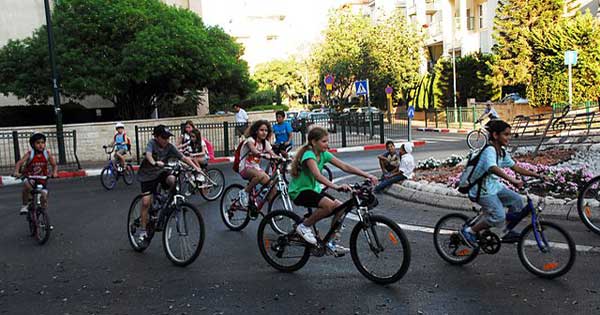
This year, the Day of Atonement, holiest day in the Jewish calendar, began on the evening of September 13. It is always a 25-hour period marked by fasting, praying, and, in Israel, bicycle-riding. For reasons that seem shrouded in mystery, on the Day of Atonement—Yom Kippur in Hebrew—all motorized traffic in Israel, aside from emergency vehicles, comes to a halt as riders of bicycles and tricycles take to the quiet streets. The phenomenon prompted a new study showing the dramatic impact of the shutdown: a plunge in polluting nitrogen oxide levels by up to 98 percent.
Ilan Levy, of Israel’s Technion Center of Excellence in Exposure Science and Environmental Health, compiled data on air pollutants at three sites during the Day of Atonement over a span of 15 years. The study measured air quality in two locations within Tel Aviv, a crowded, secular city with a metro population of 1.2 million, and the third in Modi’in, a town of 75,000 residents. He found that nitrogen oxide—a major component of smog, as well as a lung irritant, greenhouse gas, and contributor to acid rain—fell by 83 to 98 percent, dropping to near zero at some sites. At the same time, there was a moderate increase in ozone formation in urban centers, by as much as 17 percent. This, Levy explains, is a “well-known and documented behavior of ozone, known as the ‘ozone weekend effect,’” in which nitrogen oxides emitted by vehicles in heavily polluted city centers react with, and initially consume ozone.
Although there is no law mandating the traffic stoppage on Yom Kippur, Levy observes that virtually everyone in Israel, religious or not, abides by the custom. Therefore, he explains, “Yom Kippur is a unique phenomenon in terms of air pollution. In no other place in the world (as far as I could find in the literature) is there a scheduled halt in all vehicles and small emission sources (for example, small businesses and industries).”
What if everyone cycled or drove low-emission vehicles, such as hybrids or electric cars? Levy sees a world with cleaner, fresher, sweeter air. To me, his study suggests a new role and meaning for the Biblical Day of Atonement: as an environmental holiday. When I suggested as much, Levy replied, “I never thought of Yom Kippur in such terms, but yes, that could be a nice way to celebrate it for those who don’t fast and pray.”

